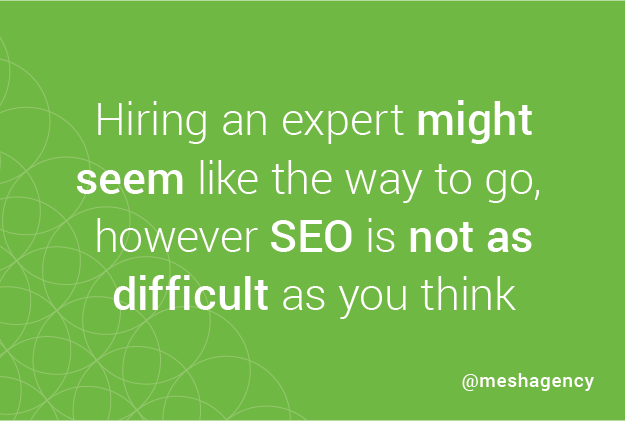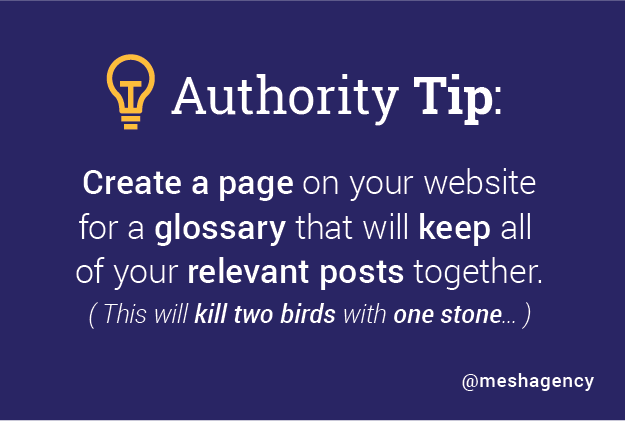Earlier this year, I was talking to the CEO of a small tech startup in Boston. They had invested in the basics: a logo, a small WordPress website, and were creating some content via a blog—mostly with their internal team. The place where they had invested their marketing budget was with an offshore SEO consultant—and they had no idea what the consultant was doing. They weren’t even sure if they were doing a “good job”.
To use his words (I’m paraphrasing a little), “I literally have no way to tell if this guy is doing anything. Yeah, we get hits on the website—so I don’t want to mess with a good thing—but we’re starting to look at developing a broader marketing campaign. I don’t know much about marketing, but I’m pretty sure if he were to take on a full marketing strategy, he’d be trying to punch above his weight class. My concern, based on the Skype calls we’ve had, is that if we leave, we might have a serious problem with him—if you know what I mean.”
Yes, unfortunately, I know what he means.
At first, hiring an SEO consultant seems like a great idea. Optimizing your site for search engines while building an audience is a requirement today, but with everything you need to do to get it right, SEO might seem out of your league. Hiring an expert seems like the way to go. Or at least, it used to be.
Succeeding with today’s SEO however, is not as difficult as you might think. I’m going to give you a quick overview of what SEO really is—demystify it really—a bit of a layperson’s understanding of how SEO works, and help you understand that you can write your own copy that is already optimized for search. So, stop wasting your money—and stop being held hostage by an SEO “guru” and use the following tips for writing your own optimized copy that people and search engines will love.
What is SEO?
According to MOZ, a leading authority and platform for winning SEO, Search Engine Optimization (or SEO)…
“…is the practice of increasing the quantity and quality of traffic to your website through organic search engine results.”
MOZ quickly breaks this SEO definition into three components:
- Quality of traffic.
You could be generating a ton of traffic to your site, but if it’s not relevant traffic that drives business, what good is it? SEO is only deemed successful if the traffic you’re getting is from visitors who are potential buyers for your specific product or service. - Quantity of traffic.
Pretty straightforward, quantity means the number of quality visitors you’re getting to your site. Once you figure out the model for getting quality traffic, you want to scale the quantity. - Organic traffic.
When you look at a search engine results page (SERP), it’s broken up into a variety of content, including Ad Space (Pay Per Click), News, and Organic Results. Organic traffic is any traffic that comes through clicking a non-paid link and content.
How does SEO work?
Traditionally (and unfortunately sometimes still), SEO was focused on just ranking, not on delivering the right content to users. Thankfully for those of us focused on delivering a quality experience to our customers, Google’s gotten a heck of a lot smarter. Unfortunately, many “gurus” and even some marketing agencies are still promoting SEO tactics that can do more harm than good. Consider some of these tactics listed by Search Engine Watch that you should avoid:
- Article Submissions
- Press Releases Without News
- Reciprocal Linking & Link Exchanges
- Losing Your Voice Through Automation
- Ignoring Social Signals
- Ignoring Design
- and more…
The reality is this: if you focus on good marketing (strategy, competitive analysis, messaging, and delivering amazing content), you’ll be doing SEO naturally, and won’t have to worry about being penalized by Google.
So… how do you write copy that’s already optimized?
Write for Your Audience, Not the Search Engine
Speak to your readers as though they’re right in front of you. After all, “Copy is a direct conversation with the consumer.”—Shirley Polykoff
Don’t use big words and confusing language. If they don’t understand what you’re saying, then they won’t buy what you’re selling. You’ll reach a wider part of the market by appealing to everyone. Use the Hemingway App to check your post’s readability.
Steer clear of tangents. Search bots aren’t people: they don’t understand how your side story is related to your subject and your rankings could suffer as a result.
41% of the US adult population uses voice search daily. That means when they’re asking Siri or Google a question, they’re not getting a list of answers read back to them: they’re getting one. Focus on the questions readers are asking and give them solutions. Don’t just tell them what features you offer. Tell them how your product will benefit them. The more relevant your information is, the higher it’ll rank in search results.
Value your readers and write content that they can use. This helps your posts stand out from the millions of other posts on the same topic. Make an effort to give them well-thought-out content. Include easy to digest how-to lists that are relevant to the context of the reader’s problem or question will also help increase your rank credibility—and therefore boost your authority.
You want to build up a reputation as a trustworthy source for your topic. If people trust you, they’re more likely to buy from you—when choosing between two sellers of the same product, would you go with the seller who has zero or few positive reviews, or the one who consistently makes customers happy?
If readers find your content valuable, then they’ll share with their social media followers. The more your content is shared, the more visibility your site has, and the better it will rank in search results.
“Since people tend to share links (content) that affect them emotionally, it’s more important than ever to understand the demographic you’re selling to.” —Debra Mastaler, Alliance-Link
If you’re having trouble deciding on who your target audience is, most people can create a “straw man” persona to start. Assign them a name, age, needs and desires. Focus on speaking to them directly, and you’ll find targeted writing easier. For companies with a more complex sale, you’ll want to invest more time in developing adaptive personas.
Research Your Topic, Long-Tail and Latent Semantic Keyword(s)
If you want readers to trust your site and use it as a resource for informative content, then you need to research. Save articles and sites you visit that are relevant to your topics and gather evidence from studies and facts that support your claims.
Keywords are words or phrases that describe your content. Spend some time finding a keyword that is relevant to your business and make a list of topics that are connected for future posts.
Trends are constantly changing, and if you don’t keep on top of them, your content will seem dated. Use Google Trends to find what’s gaining interest as well as to check if interest in your topics is declining. You can compare different search terms to see which keywords to use for the most traffic.
When people use search engines, they might not use your specific keyword. This is where long tail keywords come in. A long tail keyword has 3+ words and is more specific than a one word keyword. They’re less competitive in search results and the people searching for those phrases will find the content very relevant. Readers that land on your site due to a successful long tail keyword search are more likely to be your target customers. Long tail search makes up for more than 70% of search traffic. Use Google Keyword Planner or Long Tail Pro to find keywords.
People you want to read your content won’t necessarily choose your exact keyword when searching. They might use a synonym or a similar phrase, which are called Latent Semantic Indexing (LSI) keywords. When writing your content, throw in some of these other words and phrases, and when people search for those words, your post will be considered relevant. LSI keywords help your content rank in search results because you’re including related search terms throughout your post instead of just repeating the same keyword over and over. When you use LSI keywords, search engines will recognize their relationship to your main keyword.
Placement of keywords is also important. Don’t go nuts throwing your keyword in every few sentences. According to Brian Clark, “the only way to tell if your repetition of keywords is super or spammy is to measure that frequency against the overall length of the content. A keyword density greater than 5.5% could find you guilty of keyword stuffing, and your page could be penalized by Google.” Place your keywords in your post headline, throughout the post, and in the meta description.
Link within Your Site and to Other Quality Sites
Domain Authority determines how valuable your content is by measuring the number of inbound links your site receives and what quality the websites are that they’re coming from. When relevant, high-ranking sites link to you, search engines use these inbound links to determine how useful your content is. They improve site visibility and ranking in search engines. “Think of them (inbound links) as votes of confidence and popularity— the more a site has, the more authority and credibility it will gain.”—Ian Dodson, The Art of Digital Marketing
Try to link to older relevant posts on your site when you can. Internal linking keeps people on your site reading other posts. This reduces bounce rate while establishing your position as a trusted authority on the topic. Search bots will stay on your site longer, indexing relevant posts which in turn re-ranks them in search results.
Linking to other sites with relevant content tells readers that you appreciate other sources and consider them to be helpful to your topic. Link to posts that offer valuable information, such as support for your post topic or explanations on terms you don’t cover in-depth. In 2009, Matt Cutts (the former head of the web spam team at Google) said that “parts of [the Google] system encourage links to good sites.”
Become an Authority on Your Topic
If you only have a few articles on a topic, you won’t be considered an authority on the subject. Instead of just writing about what you feel your audience might be interested in, stay focused on a particular relevant, useful topic and work on producing content for that. Once you have a substantial amount of content, you’ll be recognized as a reliable authority and people will come to you for information.
Tip: Create a page on your website for a glossary that will keep all of your relevant posts together. This will kill two birds with one stone: you’ll have an easier time internally linking and people will find their way to the glossary and spend time reading through your other posts on the same subject.
Post regularly. Don’t post multiple articles a few days and take off for a month. Regularly posting lets people, and search bots, know when to expect new content. Once you’ve set up a rhythm of posting, stay with it. Content that bots crawl through frequently is more likely to gain traffic.
Get your name, and your content, out in the world by making yourself known throughout the Internet. Answer questions on Quora, comment and enter discussion threads on forums and other sites and blogs. You’ll become known as a regular contributor on your focused topic(s) and people will recognize your expertise. Guest blogging for other sites will showcase your knowledge and you’ll attract those sites’ regular readers.
Optimize Your Content
It’s difficult to get in-depth about a topic in 500 words. Longer copy (1,500+ words) offers more value and information and receives more traffic. If your post is too short, re-read it. You might have included terms that readers need to have explained.
1,500 words (or more) can be daunting to a reader, no matter how informative and in-depth it is. People are more likely to scan your content than read every word. Break up the block of text by shortening paragraphs and writing sentences that have less than 20 words. Call attention to key takeaways by leveraging visuals that draw the eye while making content easier to share on social media using tools like Click to Tweet.
People are likelier to search Google on their mobile devices than on computers. Having a mobile site design as well as scannable content doesn’t turn those readers away.
Take note from Jeff Bullas: “Walls of text without structure are a turn off. The key elements to well structured written content are:
- Concise sentences
- Discreet paragraphs
- Subtitles
- Bullet points
- Lists”
Add a call-to-action (CTA) at the end. This is when you direct your readers to do something for you. You can choose to ask them to subscribe to your site or purchase your product.
Google added a freshness algorithm in 2011, which pushes recent pages to the front. Take time to update older posts with current and accurate information. You can then republish the posts as new, giving your posts another chance to rank higher in the search results.
Evergreen content stays relevant longer but will need to be refreshed once in a while if new information or statistics come out.
Tip: Use the SEO Analyzer to find where you can improve weak content—or better yet, understand what your competitors’ content strategies are with a competitive analysis, and create content that ranks quickly.
Create Great Headlines
The headline is the first thing people see. If it’s generic and boring, they won’t bother clicking it, no matter how fantastic your content is. “On the average, five times as many people read the headline as read the body copy. When you have written your headline, you have spent eighty cents out of your dollar.”—David Ogilvy
Don’t ruin your first impression with readers. People should be able to tell by the title if the topic is something they’re searching for. Search engines care about the headline so place your keywords close to the beginning.
Capture people’s attention with interesting headlines. Of course, this doesn’t mean write fantastic headlines that have nothing to do with your content. Once people click through to read your post, if it doesn’t meet the expectation of the headline, then people will leave. You’ll have a high bounce rate, and if it happens often enough, search engines will consider your post to be irrelevant to the search terms you’re going for.
Trust goes down if people think you can’t deliver on your promising headline. Brian Clark of Copyblogger wrote an informative post on how to write headlines from Bob Bly’s book The Copywriter’s Handbook.
Meta Description
Before you hit publish, fill in the meta description. “The meta description is the most important feature for improving click-through rate from search results pages.” —Neil Patel
This is the little snippet that appears below the headline in the search results. It’s a great opportunity to add your keyword phrase and summarize your post in ~156 characters. Readers will know by reading this description if the post is what they’re looking for and will click through to read it.
Conclusion
While SEO may seem daunting at first, with some guidance and practice you’ll be enjoying higher search engine rankings and great traffic in no time. Have you taken the above approach to optimizing your own content for search? Have you worked with a consultant or digital marketing agency? Have you seen results?
If you’re not sure how to measure the effectiveness of your digital marketing strategy, submit a sample post to our team today, and we’ll provide you with an analysis of what you can do to improve your next post.








